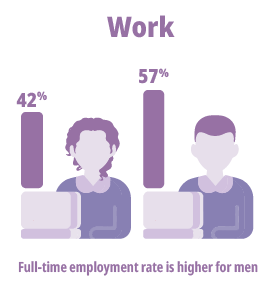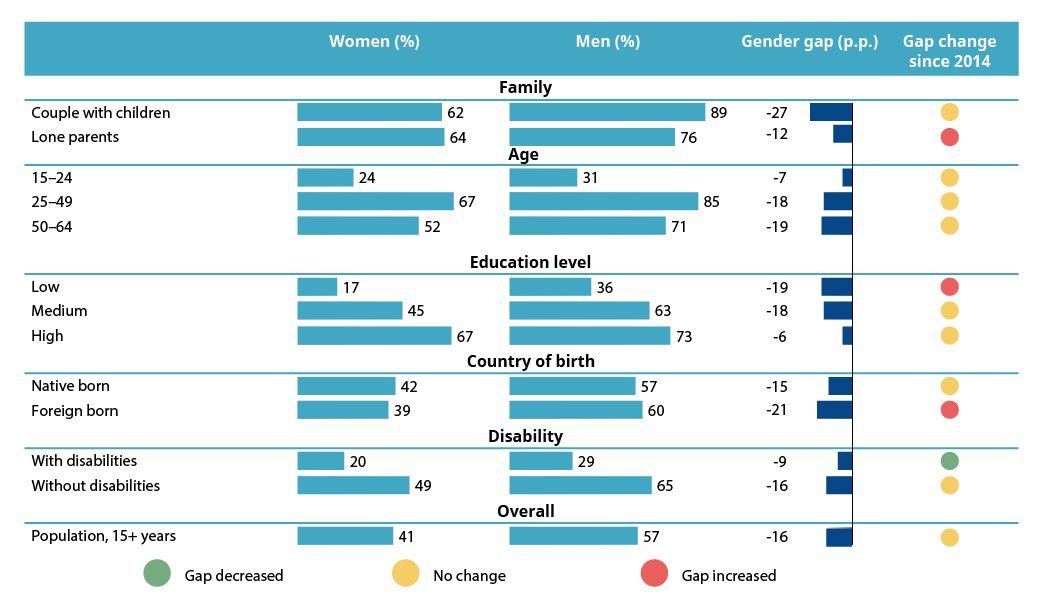Unpaid childcare still hindering women from working full time
FTE employment rates are widely divergent across population groups, and consistently disadvantageous for women. As Figure 6 shows, the largest gender gap – 27 p.p. – in FTE employment in 2019 was among couples with children, with 62 % of women, compared with 89 % of men, in this family grouping working full time. The second highest FTE employment gender gap, of 21 p.p., is among foreign-born women and men. This is followed by people with low educational qualifications, at 20 p.p. This group also had overall low rates of people working full time in 2019 – only 17 % of women and 36 % of men. FTE employment rates in 2019 for all groups of women ranged from 17 % for those with low educational qualifications to 67 % for those aged 25–49 years or for those with high educational qualifications. Among men, the lowest FTE employment rate, of 20 %, was for men with disabilities and the highest, of 89 %, was for men in couples with children (Figure 6).
Figure 6. FTE employment rates by sex, family composition, age, education level, country of birth and disability (%, 15+ years, EU, 2019)
Source: Authors’ calculation, European Union Labour Force Survey (EU-LFS). The European Union Statistics on Income and Living Conditions (EU-SILC) for disabilities is used (IE, IT, 2018).
Migrants face a host of barriers to employment, and often find it difficult to access better-quality jobs. For example, migrant women are usually limited to working in low-paid care jobs (Addati, 2018; EIGE, 2020c, 2021d). FRA (2019) reports very large gender gaps in employment rates among migrant populations in the EU. In particular, among people of North African origin, women are considerably less likely than men to be in paid work, with the gender gap ranging from 19 p.p. in France to 40 p.p. in Italy. Similarly, in Austria, the employment rate among women of Turkish origin is more than 45 p.p. lower than for men of Turkish origin (FRA, 2019).

Although FTE employment rates have been increasing for women and men – rising from 39 % in 2014 to 42 % in 2019 for women and from 55 % to 57 % in the same period for men – persistent and large gender gaps are cause for concern. This includes the gap between women and men in couples with children, highlighting how unpaid care duties remain a major obstacle to women taking on paid jobs. This enduring gap across time also points to the failure to implement the structural change that is necessary to accelerate progress in the area of FTE employment among women with children. The COVID-19 crisis has exacerbated the situation. Despite unpaid care acting as a major buffer in managing the spread of COVID-19 and reducing the degree of economic lockdowns (Klatzer and Rinaldi, 2020), those taking on most of that unpaid care – namely parents, especially mothers – accounted for most job losses (EIGE, 2021c).
FTE employment gender gaps among people with low educational qualifications and the foreign born also increased in 2019 compared with 2014. The gap increase among the latter group is worrying because it could signal a strengthening of gender stereotypes and norms, and because there is mounting evidence that foreign-born people are disproportionately affected by the COVID-19 crisis (EIGE, 2021c).
Although the employment gap between women and men with disabilities declined in 2019, this finding should be treated with caution and further monitored. This group is relatively small, and a major contributor to the change was the statistical adjustment of the Gender Equality Index data to an EU-27 level of analysis, excluding the United Kingdom.
